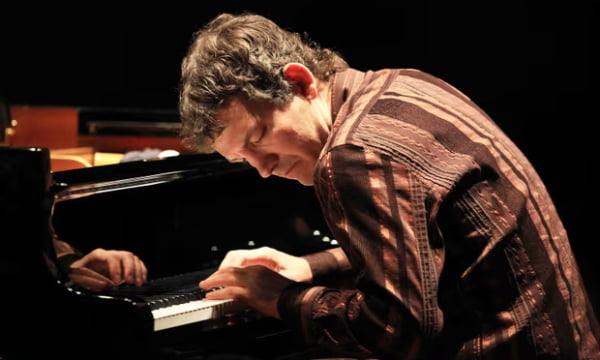Brad Mehldau has always drawn from classical music as well as jazz in his pianistic practice, finding in their confluence a persuasive and distinctly personal voice. Today he announced two new solo piano albums that speak to the play of those influences: After Bach II and Après Fauré, both due on Nonesuch Records on May 10.
As the title suggests, the first of these is a sequel to After Bach, a 2018 release that featured Mehldau’s dynamic interpretation of pieces from the Well-Tempered Clavier. There are four preludes and one fugue from the same book on After Bach II, along with the Allemande from the Fourth Partita, interspersed with original ruminations both improvised and composed. (Among these offerings: “Variations on Bach’s Goldberg Theme.”) Nonesuch has shared two pieces from the album: a soulfully contrapuntal original titled “Between Bach,” and the Fugue No. 20 in A Minor.
“The more you try to engage with him, the more your own personality becomes visible, unavoidably,” Mehldau writes of Bach’s influence in his liner notes. Alluding to the constant negotiation of harmony and melody in the music, he adds: “This is why Bach is a model for me as a jazz musician. In my improvised solos, I want to make melodic phrases that carry harmonic implication, and create harmony that moves in a melodic fashion. This is a crucial component in the storytelling.”
Après Fauré features four of Gabriel Fauré’s 13 Nocturnes, and a portion of his Piano Quartet in G Minor (specifically, a reduction of the Adagio). The album also pays homage with four new Mehldau compositions — “Prelude,” “Caprice,” “Nocturne” and “Vision” — nestled as a suite. His “Prelude” is available now, with an animated scrolling score.
auré’s harmonic imprint is on all four,” explains Mehldau in a statement. “There is also a textural influence, in terms of how he presented his musical material pianistically — he exploited the instrument’s sonority masterfully, as an expressive means. So, for example, in my first ‘Prelude,’ melody is welded to a continuous arpeggiation, both part of it and hovering above it; in my ‘Nocturne,’ it is possible to hear the harkening chordal approach in the opening of Fauré’s No. 12.”
Both Après Fauré and After Bach II underscore the deep synthesis in Mehldau’s concept as an interpreter of the classical tradition, and a composer-improviser carrying its lessons forward. Next Friday, he’ll perform a solo concert at the Big Ears Festival in Knoxville — and take part in a panel that I’ll be moderating, alongside his fellow composers Darcy James Argue and Anna Webber. The name of the panel is “Composure,” as fitting a descriptor as you’ll find when Mehldau’s work is under consideration.
No composer looms over modern jazz quite like Johann Sebastian Bach, whose harmonic rigour seems to have provided the basis for bebop and all that followed. Listen to the endlessly mutating semiquavers tumbling from Charlie Parker’s saxophone and it could be the top line of a Bach fantasia; the jolting cycle of chords in John Coltrane’s Giant Steps could come straight from a Bach fugue and Bach’s contrapuntal techniques crop up in countless jazz pianists, from Bill Evans to Nina Simone.
Bach certainly casts a long shadow over US pianist Brad Mehldau: even when he’s gently mutilating pieces by Radiohead, Nick Drake or the Beatles, he sounds like Glenn Gould ripping into the Goldberg Variations. Which is why it comes as no surprise to see Mehldau recording an entire album inspired by Bach.
However, this is not a jazz album. Instead of riffing on Bach themes, as the likes of Jacques Loussier or the Modern Jazz Quartet have done in the past, After Bach sees Mehldau using Bach’s methodology. Mehldau plays five of Bach’s canonic 48 Preludes and Fugues, each followed by his own modern 21st-century response. For instance, after a straight performance of the Prelude No 3 in C-sharp major, Mehldau responds by resetting Bach’s original riff in a jerky 5/4 rhythm and taking it into a harmonically adventurous labyrinth. Similarly, a romantic, rubato-heavy reading of the F minor Prelude and Fugue is followed by a dreamlike meditation on some of the themes hinted at in Bach’s original. The effect is as if someone has taken pages from The Well-Tempered Clavier, turned them upside down and reflected them in a wobbly fairground mirror.
Where Bach’s preludes and fugues are like gentle sudoku puzzles, Mehldau’s cryptic harmonies sometimes feel as if you’re grappling with an insoluble 5×5 Rubik’s Cube and the results – as with the opening track, Benediction – can sometimes be headache-inducing. However, by the two closing tracks, Ostinato and Prayer for Healing, Mehldau is wearing his chops lightly and starting to tug at the heartstrings.
